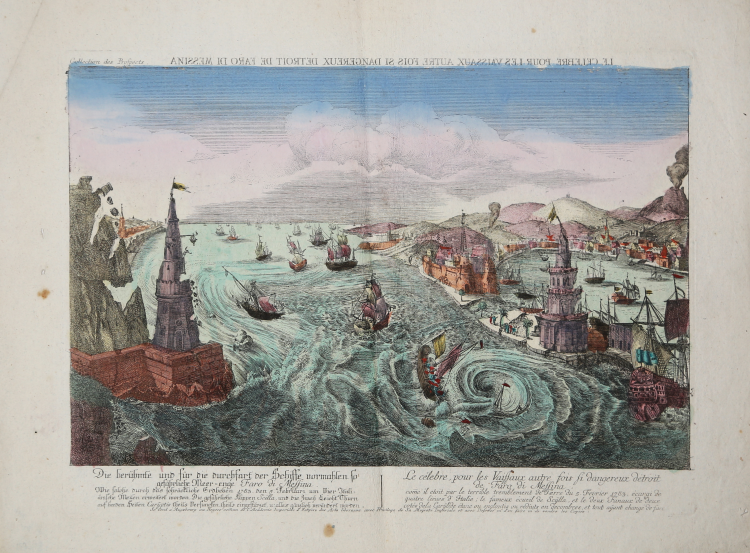



| Reference: | s30633 |
| Author | Georg Balthasar PROBST |
| Year: | 1785 ca. |
| Zone: | Stretto di Messina |
| Printed: | Augsburg |
| Measures: | 400 x 300 mm |


| Reference: | s30633 |
| Author | Georg Balthasar PROBST |
| Year: | 1785 ca. |
| Zone: | Stretto di Messina |
| Printed: | Augsburg |
| Measures: | 400 x 300 mm |
Rare view depicting the terrible seaquake of 6 February 1783, triggered by the violent earthquake that affected the whole area of Calabria, south of Cosenza, and the territory of Messina, in Sicily, sowing death and destruction.
The views in this series were intended to be seen through the zogroscope, an optical instrument equipped with a magnifying glass and a reflecting mirror placed at 45°.
The image was placed upside down at the base and observed through the large convex lens in the mirror, where it was seen upright, enlarged and three-dimensional; this explains why the title at the top is printed upside down.
Copperplate, original colouring, bilingual German and French legend, in very good condition.
Georg Balthasar PROBST (1732-1801)
|
Georg Balthasar Probst was a German artist, engraver and publisher in Augsburg, a major European publishing center in the 17th and 18th centuries. He produced architectural views of places around the world intended as vues d’optiques, which were published in various places during the last half of the 18th century, including Paris, Augsburg and London. He was also known for his portraits.
Probst came from an extended family of printers, whose businesses can all be traced back to the publishing firm of Jeremias Wolff (1663-1724). After Wolff's death his firm was continued as “Wolff’s Heirs” (Haeres Jer. Wolffii) by his son-in-law Johann Balthasar Probst (1689-1750). After Probst’s death in 1750, his descendants divided the business and published under their own imprints: Johann Friedrich Probst (1721-1781), Georg Balthasar Probst (1732-1801) and Johann Michael Probst.
Another part of the Wolff-Probst firm was acquired by the Augsburg publisher Johann Georg Hertel (1700-1775), whose son Georg Leopold Hertel had married a sister of the Probsts. In the next generation, Georg Mathäus Probst (d. 1788), son of Georg Balthasar Probst, also became an engraver of portraits and views.
|
Georg Balthasar PROBST (1732-1801)
|
Georg Balthasar Probst was a German artist, engraver and publisher in Augsburg, a major European publishing center in the 17th and 18th centuries. He produced architectural views of places around the world intended as vues d’optiques, which were published in various places during the last half of the 18th century, including Paris, Augsburg and London. He was also known for his portraits.
Probst came from an extended family of printers, whose businesses can all be traced back to the publishing firm of Jeremias Wolff (1663-1724). After Wolff's death his firm was continued as “Wolff’s Heirs” (Haeres Jer. Wolffii) by his son-in-law Johann Balthasar Probst (1689-1750). After Probst’s death in 1750, his descendants divided the business and published under their own imprints: Johann Friedrich Probst (1721-1781), Georg Balthasar Probst (1732-1801) and Johann Michael Probst.
Another part of the Wolff-Probst firm was acquired by the Augsburg publisher Johann Georg Hertel (1700-1775), whose son Georg Leopold Hertel had married a sister of the Probsts. In the next generation, Georg Mathäus Probst (d. 1788), son of Georg Balthasar Probst, also became an engraver of portraits and views.
|